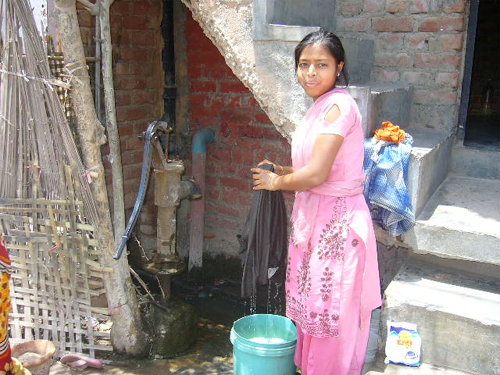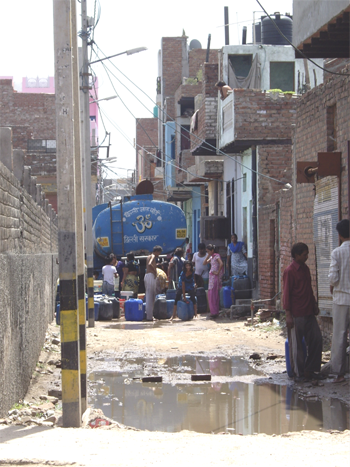Dec 05, 2025
Dec 05, 2025

Among the multiplying divides between people in a world full of disparities, is one that is hardly talked or written about. Urbanologist Mike Davis is a rare exception. In his work, 'Planet of Slums', he lays bare the grid of deprivation that is the Third World city, where water and sewerage systems continue to elude the millions living on its fringes in teeming shanty towns and resettlement colonies. Davis writes: “Constant intimacy with other people's waste, is one of the most profound of social divides... living in shit - truly demarcates two existential humanities."
| There are four imperatives that need iteration. The first is to broaden the general understanding of the lived realities of those who live on the margins. India’s middle classes have long stigmatised the poor for the unhygienic situations in which they live. |
Much like financial poverty or inadequate nutrition, the lack of clean water and toilets undermines people’s health, well-being and progress. According to the Human Development Report 2006, which terms the crisis in water and sanitation as “one of the great human development challenges of the early 21st century”, an estimated 1.1 billion people in the world today don’t know what it is like to have clean water flowing through a tap in their homes, and 2.6 billion lack basic sanitation. But despite the enormity of the numbers, the crisis has remained a silent one precisely because those who are most affected by it are also the least visible, articulate and influential.
In this dystopian scenario it is women who pay the highest price, not just in terms of their time and money but in terms of their safety and dignity. Being poor, powerless, voiceless and of the ‘wrong’ gender, they are inevitably met with administrative inertia. Says Renu Khosla, Director, Centre for Urban and Regional Excellence, a Delhi-based NGO working in slums and resettlement colonies, “As privileged urbanites, we take water and sanitation for granted. But if you talk to women in slums or resettlement colonies, their primary concern is the endless struggle to access these services. For our administrators, planners and engineers, they don’t seem to exist.”
No one in a government department is actually counting the costs incurred by those who ironically have the least capacity to pay the bill. Take the price of accessing a toilet. Since homes in most slums and settlements don’t have toilets, a family of five could spend Rs 300 at the very minimum every month, just to relieve themselves. If you look at this figure a little more closely, more tragic everyday realities emerge – stories of how family members, especially the women, try and avoid going to the bathroom too often and end up with serious health conditions.
Other health problems like water-borne diseases proliferate in neighbourhoods where overflowing gutters easily spill into drinking water sources. Khosla’s organisation once did a study in an Agra slum on the incidence of such diseases, the cost of medical treatment and time spent in getting treated. It revealed that families were spending, on an average, Rs 700 (US$1=Rs 44.9) every month for treating water-borne diseases in the family. As HDR 2006 observes, “Water and sanitation are among the most powerful preventive medicines available to government to reduce infectious diseases”.
 Procuring water from the local hand pump, stand pole or tanker is extremely stressful activity – with fights breaking out between neighbours and tensions being created within households. It affects children’s schooling, creates hostility and insecurity, and carries huge opportunity costs. The quality of water that is accessed with so much trouble is also invariably abysmal. Those who have waited for hours in line for it, talk of how it is not uncommon to spot a dead rodent or lizard in the water or how it is sometimes so brackish that clothes turn yellow when washed in it.
Procuring water from the local hand pump, stand pole or tanker is extremely stressful activity – with fights breaking out between neighbours and tensions being created within households. It affects children’s schooling, creates hostility and insecurity, and carries huge opportunity costs. The quality of water that is accessed with so much trouble is also invariably abysmal. Those who have waited for hours in line for it, talk of how it is not uncommon to spot a dead rodent or lizard in the water or how it is sometimes so brackish that clothes turn yellow when washed in it.
The running of public toilets is marked by similar indifference, with their management contracted and sub-contracted until no institution or individual can be held accountable when lights don’t work, when water runs out or when the facility is shut down arbitrarily. Women talk about what a serious challenge a non-functioning toilet is when they are menstruating. The system, of course, remains impervious to such needs and has come to regard them as people who don’t need clean water or proper toilets.
But things are changing. Increasingly, women activists and civil society organisations are beginning to realise that expanding women’s choices and life chances hinges crucially on seemingly banal issues like clean water and functioning toilets.
There are four imperatives that need iteration. The first is to broaden the general understanding of the lived realities of those who live on the margins. India’s middle classes have long stigmatised the poor for the unhygienic situations in which they live. But as one woman in a Delhi resettlement colony remarked, “We don’t want to live like this, we don’t want to defecate in the open. But what can we do when the drains overflow and the public toilets are locked?” The sewer, as Victor Hugo wrote in ‘Les Miserables’ all those years ago, is the “conscience of the city…it tells everything”.
Second, we need to regard water and sanitation as a women’s issue that has everything to do with individual security and personal dignity. Says Prabha Khosla, consultant for the Jagori-Women In Cities International action research project on ‘Women's Rights and Access to Water and Sanitation in Asian Cities’, “For me, the word ‘dignity’ has to be embedded in the context of women’s rights. It has to be broadened to encompass the day-to-day lives of women.”
Making communities - and the women in them - more articulate about their right to water and sanitation is the third big imperative. Poor people have been shortchanged precisely because policy makers and administrators think they can get away with it. This is where awareness raising and leadership building has yielded impressive results, with many women – once too inhibited to speak out in public – coming forward to confront senior bureaucrats and municipal functionaries.
Finally, it is about changing old, entrenched mindsets within governments and local bodies. Prabha recalls how she once had to confront an engineer in Uganda because he just did not understand why women needed to be consulted before a public facility was built. “Governments and public officials tend to perceive infrastructure as gender neutral. Pipes are pipes and taps are taps, for both men and women – that is the common sense. But this is really not the case. We know that even something like the design of a toilet can have profound consequences for women. So the question is: How deep do women’s concerns permeate policy making and its implementation?”
Ultimately, this issue is not just about poverty, but about the poverty of policy making. It is not merely about taps and pipes, but about women’s lives.
By arrangement with WFS
11-Jun-2011
More by : Pamela Philipose